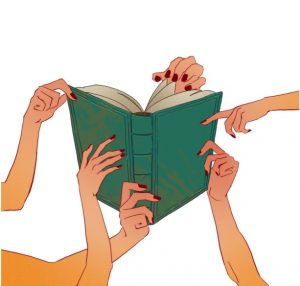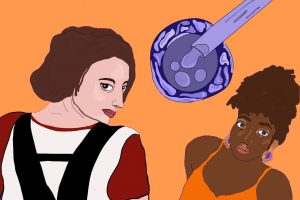Painless Consequences: Cisgender Women’s Pain and Why We Ignore It
by Nidhi Mekapothu | January 18, 2024
Women are born with pain built in—it’s our physical destiny … We carry it within ourselves throughout our lives, men don’t … We have pain on a cycle for years and years and years … and then … the fucking menopause comes, and it is the most wonderful fucking thing in the world … then you’re free, no longer a slave, no longer a machine with parts. You’re just a person.
Phoebe Waller–Bridge, Fleabag
To be a woman is to exist within a body that feels like it belongs to everyone but its owner. This body is constantly contested, becoming the site of a dissonance between ‘vessel’ and self. Sexualised, stigmatised, and judged, our outward appearance is what we end up becoming—we are slaves to the ordeal of an ideal. This constant pain, both psychic and physical, becomes part of who we are, inseparable from our identities as women. But this unifying experience is one that happens on the sidelines, that cannot and will not be spoken about—belittled by ourselves, and dismissed by others. Why is this the case?
What sets pain apart from other symptoms is that it is subjective. Doctors use the visual analogue scale (asking a patient to rate their pain on a scale of one-ten) to quantify it, but, as Elaine Scarry writes, pain is the “divorcing of one’s own reality and that of others.” This separation is best understood by acknowledging that pain is bio-psycho-social. It cannot be confined to just one referent due to its reciprocal nature with the environments it exists within—the body, and beyond. Pain that we have never felt cannot be imagined, so empathy for others’ pain doesn’t come naturally. In the medical field, this means that trust must be embedded within the channel of communication between doctor and patient: the socialised aspect of pain, as it were. This trust is notably absent in situations including female patients, leaving their pain more isolated and less validated than their male counterparts. This is a pattern of behaviour that negatively impacts women, and we need to unpack the stories told on an individual and societal level that justify this.
The history of medical research is a long and dark one beginning with The Book of Daniel, which describes an experiment conducted by the Babylonian king Nebuchadnezzar. He chose two groups of youths and put each on different diets for three years to see which was healthiest at the end. This experiment would not run today—its strict rules, the power dynamics at play, and potential physical and mental harm to the subjects clearly make it unethical—but it laid the foundation upon which medical research would be built for millennia. A similar pattern of exploitation is clear in the US, where enslaved people were used as bodies to experiment on. Narratives of Black individuals having thicker skin and less sensitive nervous systems were created by slave masters and physicians alike to justify their abuse of other human beings, and the effects of these beliefs have spilled over into modern medicine. Half of the White medical residents and students in the US believed at least one racialised falsehood in 2016 according to research done by the University of Virginia. This clearly indicates an institutional problem, a systematic approach to medical teaching that fails students and patients alike.
One of the most infamous executors of this cruelty was J. Sims, the ‘Father of American gynaecology’ (some jokes write themselves). The US federal government made the importation of enslaved people illegal in 1808, creating a reliance on domestic births to perpetuate the industry of exploitation. Sims conducted experiments on the genitalia of Black women over a period of four years, opting not to use any anaesthetic despite its recent introduction. Prior to his work, gynaecology was not taken seriously within medicine—unsurprising for a male-dominated field. These beliefs, rooted in misogyny and racism, filter down and become part of the collective consciousness. With little done to actively work against this, Sims’ racist foundations have had tangible effects upon modern gynaecology: Black women are more than four times likelier to die from pregnancy-related causes than their White counterparts, according to the MBRRACE (Mothers and Babies: Reducing Risk through Audits and Confidential Enquiries) report.
A strikingly modern example of this phenomenon can be found when examining the Yale Fertility Centre scandal of 2020. A nurse working in an egg retrieval unit replaced vials of fentanyl (a local anaesthetic) with saline in order to satisfy her opioid addiction over a period of at least six months. Patients then underwent the procedure—having a needle placed through the vaginal canal into the uterus—without being medicated. There are numerous accounts of these women kicking and screaming due to their pain, begging doctors and nurses to take them seriously. The women were ignored, and their pain was labelled “unusual and curious”. Since there were no apparent long-term effects on their fertility, no further investigations were launched into why so many women were in excruciating pain. The doctors didn’t believe them, or they didn’t care enough to do anything about it.
I cannot help but wonder what stories the women and the doctors told themselves. Sims’ view of the world was formed by racist ideology—these doctors didn’t become misogynists overnight, so this scandal speaks to similarly ingrained beliefs. The narrative of the hysterical woman prevails in the medical profession, compounded over a millennium; the word ‘hysteria’ comes from the Latin ‘hystericus’, meaning uterus. When a woman is hysterical, it is because her womb is loose in her body, causing havoc and manifesting itself through her behaviour. She is no more than the sum of her parts, her physical sensations denounced even as her body is used to define her.
Through the examination of chronic pain, this perception of the hysterical woman is concretised. The International Association for the Study of Pain (IASP) found that “women experience more recurrent pain, more severe pain, and longer lasting pain than men,” but are less likely to receive treatment for it. Not only are there more female-specific illnesses that cause chronic pain due to our complex reproductive system (such as endometriosis), but women are at higher risk for almost every illness that causes this, from migraines to musculoskeletal diseases. Fibromyalgia, for example, is a chronic illness that, for as–yet–unknown reasons, causes widespread chronic pain across the body, and 80–90% of diagnosed cases are women (IASP). Most of the time these are not fatal, but this doesn’t mean that they are not extremely painful and recurrent. In a world so focused on results and statistics (thanks, capitalism!), non–quantifiable measurements are often swept under the rug. A medical institution can accurately report numbers of hospitalities and mortalities, but not the amount of pain its patients are in. Chronic pain can thus be kept out of mind as it is entirely out of sight. This cannot be unrelated to the fact that those suffering are women, and that women’s pain is both inexpressible and unheard within a language and a culture structured around disregarding it.
When the treatment of pain is investigated, researchers often investigate the ‘anaesthetics’ that are prescribed to individuals, but this umbrella term can obfuscate reality. Within the category of anaesthetics, there are two distinct types of medication: sedative—which, as you guessed, sedate the patient, making them sleepy—and analgesics, which change the brain’s perception of pain. Women are more likely than men to be prescribed sedatives after operations (Calerdone), stripping them of their ability to sense and communicate pain. Indeed, almost exclusively sedatives are an attempt to “calm overly emotional women” (ibid.). Not only does this have obvious mental consequences, but severe pain post-operation is associated with increased risk of respiratory infections, cardiac failure, and chronic pain. Our current and historical healthcare systems fail half of their patients, and we continue to allow them to do so.
This dismissal of women’s pain has not always been the cultural norm. Traditional Hindu Vedas dictate that women on their periods should have to stay outside the house, undisturbed by children and banned from any form of housework. This was to protect their peace and give them space while they were in pain, a deliberate display of respect to the female body and what it endures. While this practice is still enforced in many parts of India today, it has been warped since British colonisation, which imposed Western patriarchal ideology upon the nation. While the same actions are being taken outwardly, the Western lens means that what was once done to protect has now become the instrument of shame and punishment, the exile of a ‘hysterical woman.’ The bio–psycho–social elements of pain all play a role here, exacerbating an innately isolating experience through the trauma of exclusion—all over a natural bodily process. As Maia Schwartz put it, “[m]enstruation is the only blood that is not born from violence, yet it’s the one that disgusts you the most.”
This change is indicative of a larger phenomenon in which the patriarchal foundations of Western society seep into structures supposedly far above them. The expression of pain already resists language. In fact, as Scarry writes, “pain does not simply resist language but actively destroys it, bringing about … the sounds and cries a human being makes before language is learned.” Pain predates both language and culture, yet our expression of it has been shaped by societal norms. The journey between experiencing pain and having others understand it is different for men and women—their very language is interpreted differently. While men’s expression of pain is understood as a transparent signifier of something being inherently wrong within the body, the same outward presentation made by a woman is read as a sign of her inability to tolerate discomfort, as a ‘weakness’ bound up with womanhood. This interpretation is incentivised by the patriarchy, a system that benefits from dismissing this suffering in order to further exploit its bearer.
With no tangible repercussions for this ignorance of pain, how can we hope to validate it? Liberating the body from this pain feels as unimaginable as liberation from patriarchy; an abstract concept that appears continually out of reach. The goal is simply to exist within a body, not a machine fighting against itself. To finally just be a person. ∎
Words by Nidhi Mekapothu. Art by Poppy Williams.
![‘Fiction’s about what it is to be a fucking human being’ [David Foster Wallace]. Is it? 6970074272_f580c22601_o](https://isismagazine.org.uk/wp-content/uploads/2015/03/6970074272_f580c22601_o-227x300.jpg)



